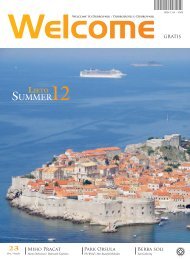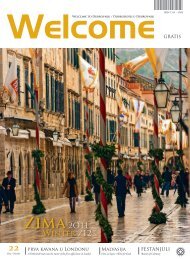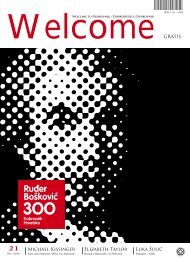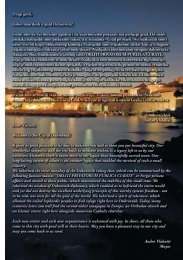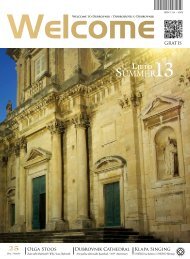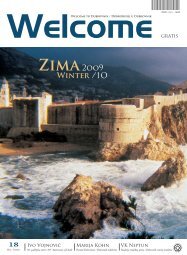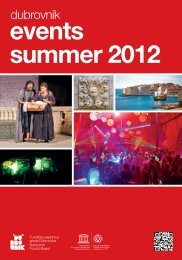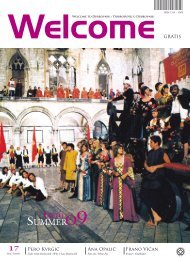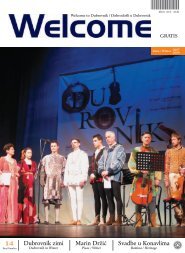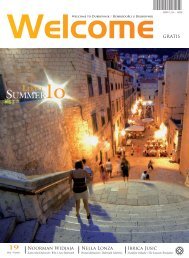WELCOME Magazine 16 - TuristiÄka zajednica grada Dubrovnika
WELCOME Magazine 16 - TuristiÄka zajednica grada Dubrovnika
WELCOME Magazine 16 - TuristiÄka zajednica grada Dubrovnika
Create successful ePaper yourself
Turn your PDF publications into a flip-book with our unique Google optimized e-Paper software.
By Sanja Dražić<br />
Thirtieth Anniversary of Cappella Ragusina<br />
– Linđo «N» Vocal Group<br />
Croatian<br />
Music Heritage<br />
Lovers<br />
Many anniversaries which<br />
we celebrate remind us<br />
that some individual or<br />
ensemble is still active. It sometime happens<br />
that we have almost forgotten the<br />
honouree, since he is no longer present<br />
in public and every-day life. However,<br />
the Croatian early and traditional<br />
music ensemble Cappella Ragusina has<br />
a completely different story. It is not<br />
only the ensemble which has continuously<br />
been active for thirty years now,<br />
but we may well say that appearing in<br />
their picturesque costumes the ensemble<br />
members have been enriching our<br />
cultural life all the time with an ever<br />
increasing zeal and performing nerve.<br />
And it more and more comprises – deservedly<br />
– the Croatian music heritage,<br />
both old and new. The Linđo Vocal<br />
Group, which grew into the Croatian<br />
early and traditional music ensemble<br />
Cappella Ragusina - The Linđo «N»<br />
Vocal Group, was founded by four<br />
musicians: Krešimir Magdić, singer,<br />
player and music leader, soprano Ilka<br />
Zec Ðapo, bass Vinko Dragojević and<br />
baritone Nikola Cvjetković (in whose<br />
honour, after his death, the Vocal Group<br />
added the letter „N“ to its name). If<br />
you attend some of their concerts today,<br />
in addition to the unchangeable trefoil<br />
Magdić – Zec Ðapo – Dragojević, you<br />
can listen to soprano Paulina Ðapo,<br />
tenor Ivan Sušac, countertenor Mario<br />
Miladin, baritone Tomislav Marinović,<br />
bass Vicko Dragojević (lute and guitar),<br />
lutenist Joško Berdović and violinist<br />
Viktor Lenert.<br />
The Ensemble’s first appearance at the<br />
1979 Dalmatian Vocal Groups Festival<br />
in Omiš brought it the best debutant<br />
title. Performing continuously at the<br />
festival finales ever since, this vocal<br />
group has won numerous awards and<br />
prizes for interpreting both traditional<br />
and new songs. Apart from professional<br />
juries, the audiences have also recognized<br />
the quality and importance of the<br />
Ensemble awarding it 1st prizes several<br />
times. The Omiš Festival presented<br />
the Ensemble with numerous jubilee<br />
plaquettes, and in 1997 chose it to<br />
perform in the Vatican before Pope John<br />
Paul II. For its early music concert at the<br />
42nd Dubrovnik Summer Festival the<br />
Ensemble was awarded Orlando Award<br />
for the best musical performance. The<br />
Ensemble has released a large number of<br />
CDs with Dalmatian vocal-group songs,<br />
the Croatian early music, the Glagolitic<br />
Chant and numerous carols.<br />
«The appearance of new ethno-musicological<br />
and musicological materials in<br />
the research of father Miho Demović,<br />
Ph.D.» – said Krešimir Magdić – «inspired<br />
me for this combination of vocal<br />
group and ensemble.» He claims that<br />
a discovered piece draws you further<br />
on, and this is a never-ending work.<br />
Thanks to the fact that Mr. Magdić is a<br />
Christmas service cantor in St Dominic’s<br />
Church, the Ensemble rehearses there.<br />
Commenting the venues of which the<br />
acoustics are most suitable for the<br />
Ensemble’s performances, he claims:<br />
«Many venues in the City have the<br />
problem of noise, while some have either<br />
too quiet or blurred acoustics. The<br />
Benedictine Monastery Atrium is the<br />
most convenient for the Ensemble. We<br />
would like to perform in the Holy Spirit<br />
Church on the Island of Šipan, which is<br />
not used at all. It has the finest acoustics<br />
that even has its own colour.»<br />
The Ensemble is preparing a new CD<br />
with the traditional Glagolitic chant,<br />
which makes the Croatian musical heritage<br />
recognizable and specific within the<br />
European context.<br />
Wel c o m e to Du b r o v n i k 21



